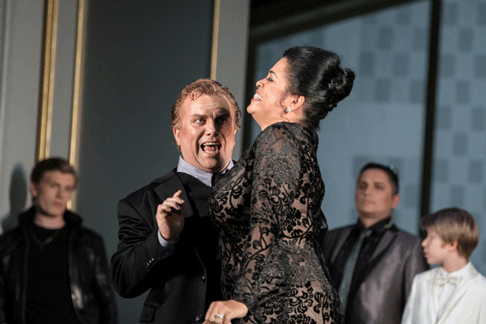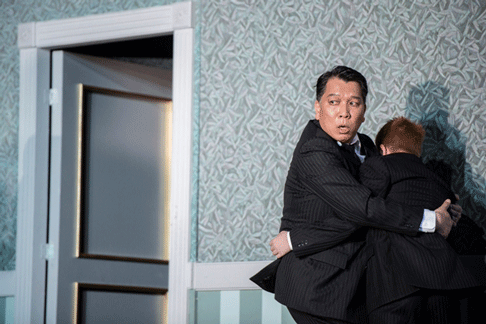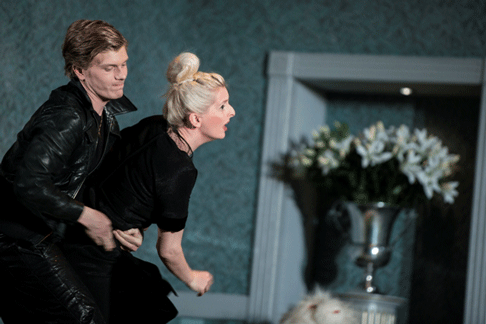![Melba Ramos as Lady Macbeth and Olafur Sigurdarson as Macbeth with Opernchor des SST [Photo by Thomas M. Jauk]](http://www.operatoday.com/559d7ad5d8.gif)
19 May 2014
Verdi’s Macbeth of the Living Dead
If it is supposed to bring bad luck to even whisper the name of the “Scottish Play” out loud, someone must have screamed Macbeth deafeningly before the performance at Saarbrücken’s State Opera House.
English Touring Opera are delighted to announce a season of lyric monodramas to tour nationally from October to December. The season features music for solo singer and piano by Argento, Britten, Tippett and Shostakovich with a bold and inventive approach to making opera during social distancing.
This tenth of ten Live from London concerts was in fact a recorded live performance from California. It was no less enjoyable for that, and it was also uplifting to learn that this wasn’t in fact the ‘last’ LfL event that we will be able to enjoy, courtesy of VOCES8 and their fellow vocal ensembles (more below …).
Ever since Wigmore Hall announced their superb series of autumn concerts, all streamed live and available free of charge, I’d been looking forward to this song recital by Ian Bostridge and Imogen Cooper.
Although Stile Antico’s programme article for their Live from London recital introduced their selection from the many treasures of the English Renaissance in the context of the theological debates and upheavals of the Tudor and Elizabethan years, their performance was more evocative of private chamber music than of public liturgy.
Evidently, face masks don’t stifle appreciative “Bravo!”s. And, reducing audience numbers doesn’t lower the volume of such acclamations. For, the audience at Wigmore Hall gave soprano Elizabeth Llewellyn and pianist Simon Lepper a greatly deserved warm reception and hearty response following this lunchtime recital of late-Romantic song.
For this week’s Live from London vocal recital we moved from the home of VOCES8, St Anne and St Agnes in the City of London, to Kings Place, where The Sixteen - who have been associate artists at the venue for some time - presented a programme of music and words bound together by the theme of ‘reflection’.
'Such is your divine Disposation that both you excellently understand, and royally entertaine the Exercise of Musicke.’
‘And there was war in heaven: Michael and his angels fought against the dragon; and the dragon fought and his angels, And prevailed not; neither was their place found any more in heaven … that old serpent … Satan, which deceiveth the whole world: he was cast out into the earth, and his angels were cast out with him.’
There was never any doubt that the fifth of the twelve Met Stars Live in Concert broadcasts was going to be a palpably intense and vivid event, as well as a musically stunning and theatrically enervating experience.
‘Love’ was the theme for this Live from London performance by Apollo5. Given the complexity and diversity of that human emotion, and Apollo5’s reputation for versatility and diverse repertoire, ranging from Renaissance choral music to jazz, from contemporary classical works to popular song, it was no surprise that their programme spanned 500 years and several musical styles.
The Academy of St Martin in the Fields have titled their autumn series of eight concerts - which are taking place at 5pm and 7.30pm on two Saturdays each month at their home venue in Trafalgar Square, and being filmed for streaming the following Thursday - ‘re:connect’.
The London Symphony Orchestra opened their Autumn 2020 season with a homage to Oliver Knussen, who died at the age of 66 in July 2018. The programme traced a national musical lineage through the twentieth century, from Britten to Knussen, on to Mark-Anthony Turnage, and entwining the LSO and Rattle too.
With the Live from London digital vocal festival entering the second half of the series, the festival’s host, VOCES8, returned to their home at St Annes and St Agnes in the City of London to present a sequence of ‘Choral Dances’ - vocal music inspired by dance, embracing diverse genres from the Renaissance madrigal to swing jazz.
Just a few unison string wriggles from the opening of Mozart’s overture to Le nozze di Figaro are enough to make any opera-lover perch on the edge of their seat, in excited anticipation of the drama in music to come, so there could be no other curtain-raiser for this Gala Concert at the Royal Opera House, the latest instalment from ‘their House’ to ‘our houses’.
"Before the ending of the day, creator of all things, we pray that, with your accustomed mercy, you may watch over us."
The doors at The Metropolitan Opera will not open to live audiences until 2021 at the earliest, and the likelihood of normal operatic life resuming in cities around the world looks but a distant dream at present. But, while we may not be invited from our homes into the opera house for some time yet, with its free daily screenings of past productions and its pay-per-view Met Stars Live in Concert series, the Met continues to bring opera into our homes.
Music-making at this year’s Grange Festival Opera may have fallen silent in June and July, but the country house and extensive grounds of The Grange provided an ideal setting for a weekend of twelve specially conceived ‘promenade’ performances encompassing music and dance.
There’s a “slide of harmony” and “all the bones leave your body at that moment and you collapse to the floor, it’s so extraordinary.”
“Music for a while, shall all your cares beguile.”
The hum of bees rising from myriad scented blooms; gentle strains of birdsong; the cheerful chatter of picnickers beside a still lake; decorous thwacks of leather on willow; song and music floating through the warm evening air.
![Melba Ramos as Lady Macbeth and Olafur Sigurdarson as Macbeth with Opernchor des SST [Photo by Thomas M. Jauk]](http://www.operatoday.com/559d7ad5d8.gif)
If it is supposed to bring bad luck to even whisper the name of the “Scottish Play” out loud, someone must have screamed Macbeth deafeningly before the performance at Saarbrücken’s State Opera House.
As such luck would have it, director Sebastian Welker set the whole piece alternately in a cemetery and a Mafia-infested Long Island funeral home. Mr. Welker has lots of different ideas about Macbeth. I would have settled for one. During the prelude, Malcolm as a boy, toy-sword fights with Fleance on a raked square of lawn. An open grave is far upstage, awaiting the coffin that is down center. Boys being boys, curiosity prompts them to open the coffin. (Did I mention that Malcolm is clothed in pure white with a full American Indian headdress of feathers?) Three catatonic young girls in white dresses and hair bows (refugees from “The Shining”) are the spookily mute witches, with the chorus women providing the vocals from the pit.
There is nothing wrong with the quality of Friedrich Eggert’s set designs, which are professionally executed. If you like funeral parlors, Mr. Eggert’s elaborate setting that impressively flies in with green walls, white molding, and chrome/white modern furniture embraces the highest professional standards. The many uses and change-outs of the recessed upstage bier-platform area are fluidly handled. No one is credited with the haunting lighting design, but it is restless and moody, and helps to focus the action and ground the emotional content of any given scene.
The internment of the recently departed Thane’s coffin in the first scene is the last realistic occurrence of a production that begins an inexorable (and often entertaining) descent into a macabre phantasmagoria. There are some truly chilling effects, witness the creepy appearance of the silhouettes of the three ‘witches’ behind the opaque glass in the closed doors of the upstage viewing room. There are some almost workable moments, like having the banquet stand-in as a wake, which are then reduced to silliness as the cater waiters become Banco’s assassins and Fleance cowers behind a buffet table.
 Olafur Sigurdarson, Melba Ramos, Fjölnir Ólafsson and János Ocsovai
Olafur Sigurdarson, Melba Ramos, Fjölnir Ólafsson and János Ocsovai
Some ideas are plain goofy, like having Duncan’s coffin brought in ceremoniously, but then having the pall bearers dump it with a laugh-provoking thud just as UN-ceremoniously. The party scene is complete with silver tinsel decorations, and a practical champagne class tower. The King is dead, long live the . . .Konzept.
At times the director is inconsistent with his own decisions. Having established the witches as mute girls, suddenly all the ladies chorus comes on (as Verdi intended) in Act III, all of them dressed in white dresses and bows and brandishing stuffed animals like talismans. A teddy bear is forced on Macbeth. (“Go on, take the teddy bear, take it. Take. The. Flippin’. Bear!”) He is helpless to resist. He takes it. (Oh, the horror!) A bit later, Macduff takes up the poor little Gundt, and tears the living stuffing out of it as he sings his aria, leaving little white bear balls all over the stage. BTW, Macbeth and the Missus stayed on the stage until the end (hope they pee’d at intermission), witnessing the tenor aria, dying by turns in, and next to the Le Courbusier, then being led by the girls in white to their own matching coffins upstage. (Whoever has the coffin concession in town must have had an uptick in business.) But I digress: meanwhile back with the refugees, the chorus is convened in the pit (second in ‘miserable surroundings’ to homelessness, I suppose). While Chorus Master Jaume Miranda’s fine ensemble sings some of the opera’s most affecting pages, the three witch girls make plenty of noise on stage playing skip rope, playing tag, until one by one, they vomit up blood and die. Talk about being upstaged. . .
Have I mentioned the costumes? My God, what a riot of styles and imagination designer Doey Lüthi hath wrought. For all of their excesses, they were colorful, thought-provoking, well-tailored, and individually apt for the characters. I am not sure they always functioned well as a unit, but there was much to admire. That said, there was one serious misfire with Lady Macbeth’s bold neon magenta gown. It sparkled, it blinded, it commanded the stage, and it hugged the figure. I mean, it huuuuugged. The flared tulle floor length ruffle skirt that gathered at the knees, made an attractive, short soprano seem shorter, in spite of the huge wig upswept to Greenland with its over-the-top tiara.
 Hiroshi Matsui as Banco
Hiroshi Matsui as Banco
When the Lady in Waiting and Doctor help her out of this puzzlingly garish creation for the Sleepwalking scene, and the Lady stands momentarily in a flattering black satin slip, it was a visual relief. She is a good-looking Lady! And then they proceeded to dress her in a sparkly black number that made you suspect she was about to launch into “My Man.” She dies in the (non-electric) chair, perhaps of fashion mischief.
In an odd sequence when the audience is curiously flooded with white light, Macbeth sings Pietà, rispetto, amore directly to his wife, then acts surprised when it is announced she is dead. Hmmmm. Maybe he thought she fell asleep in front of the television as usual? Having fatally hugged the tenor a ‘little’ too enthusiastically the ol’ Macduffer will have no more of it and stabs the baritone who staggers to joins his wife.
Then, in a “Ding-Dong-the-Witch-Is Dead” sort of revelry, Malcolm enters inexplicably carrying ‘himself as a boy’ on his shoulders, the crowd totes cartoonish pig head helium balloons (no kidding), and the bowed and buttoned chorus strews glitter confetti worthy of a Mummers Day parade.
Olafur Sigurdarson gave an assured reading in the title role. His substantial baritone had bite and plenty of volume. Perhaps too much. While his delivery would be terrific for Hagen and the like, Mr. Sigurdarson lacks true Italianate fluidity, and his relentless forcefulness caused him to tire a bit by opera’s end. I liked everything about Melba Ramos spunky Lady Macbeth, except perhaps that her truly lovely voice is a smidgen too small (and arguably, too darned pretty) for the anti-heroine. Still, Ms. Ramos favored us with sparkling high notes, clean coloratura, and a characterization informed by a superb musical intelligence. La luce langue could have benefitted from a bit more body in the sound, and Vieni! t'affretta! (secure, if not seething) was not helped by having Macbeth stand right next to her and recite the text of his letter, robbing her of her entrance ‘moment.’ She was at her considerable best in the ruminations of the Sleepwalking Scene, capped with an exceptional, secure high D.
 Fjölnir Ólafsson and Herdís Anna Jónasdóttir
Fjölnir Ólafsson and Herdís Anna Jónasdóttir
As Banco, Hiroshi Matsui boasted a particularly rich, sonorous bass that made for a solid musical presence. His resonant Come dal ciel precipita was a high point of the evening. Jevgenij Taruntsov brought a tightly pointed delivery to his Macduff, but sang much of the time at ‘forte’ and beyond. Mr. Taruntsov has a secure instrument that might benefit from some volume control allowing the voice move to more fluidly.
As Malcolm, János Ocsovai’s pleasant lighter tenor and his stylistically secure performance made me wish the role were larger. Young bass Fjölnir Ólafsson showed great promise with his well-schooled delivery that enhanced several small solo roles, including the Doctor.
The orchestra played idiomatically for Maestro Marzio Conti, once past an unfocussed and slack prelude. While a bit slow to warm up, once they hit their stride midway in Act I, the musical elements went from strength to strength, the final chorus ripping along with conviction and fire. Moreover, Maestro Conti partnered his soloists with a unified dramatic intent.
Whatever its excesses, this Macbeth was never boring, never less than competent, and was one of “those” productions I will not soon forget. Truth in advertising: the local, loyal audience was wildly appreciative of the night’s effort and called the cast back well past the planned number of bows.
James Sohre
Cast and production information:
Duncan: Gaetano Franzese; Macbeth: Olafur Sigurdarson; Banco: Hiroshi Matsui; Lady Macbeth: Melba Ramos; Lady in Waiting: Herdís Anna Jónasdóttir; Macduff: Jevgenij Taruntsov; Malcolm: János Ocsovai; Servant/Murderer/Messenger/First Apparition/Doctor: Fjölnir Ólafsson; Fleance/Second Apparition: Dimitrij Pyrozhkov; Boy Malcom/Third Apparition: Gustav Jänicke; Witches: Marlene Järkel, Feliciana Solander, Mira Yazici; Conductor: Marzio Conti; Director: Sebastian Welker; Set Design: Friedrich Eggert; Costume Design: Doey Lüthi; Chorus Master: Jaume Miranda.